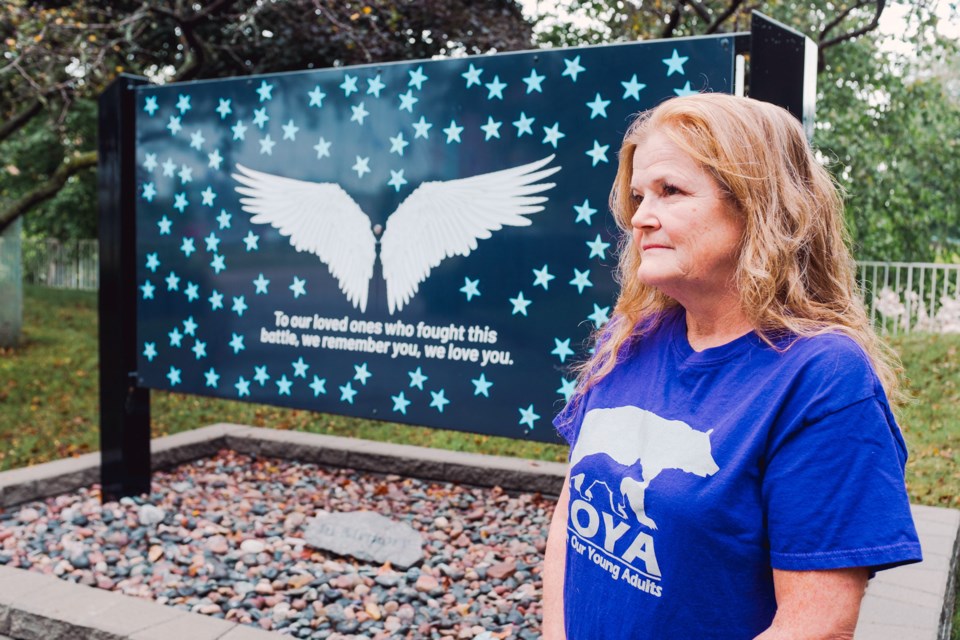The number of people dying from opioid overdoses continues to climb in Algoma District, according to new data released by the Office of Ontario’s Chief Coroner.
During the second year of the COVID-19 pandemic (April 2021 to March 2022), toxic drugs killed 59 people in Sault Ste. Marie and surrounding communities — up from 51 the previous year.
During that 12-month span, Algoma Public Health had the third-highest rate of opioid-related deaths in the province, recording 52 per 100,000 people. The year before, the rate was 44.7 per 100,000 people.
Only Thunder Bay and Sudbury recorded higher death rates.
The local spike is no surprise to Connie Raynor-Elliott, the founder of Save our Young Adults (SOYA), a grassroots organization that provides front-line services and direction to people living with addiction in Sault Ste. Marie.
Raynor-Elliott is preparing to add dozens of names to a memorial to mark Overdose Awareness Day next week. She actually believes the number of deaths is being underreported.
“I know people whose child died of an overdose and had fentanyl in their system and they died of an overdose — fentanyl wasn’t even their drug of choice — and [the death certificate] said cardiac arrest,” she said. “That is drug poisoning, that should be classified as an overdose.”
As a whole, northern Ontario has more than double the mortality rate of the entire province.
One of the differences here versus southern Ontario is a lack of access to services, said Raynor-Elliott.
“We do fill in the gaps,” she said of SOYA. “We have some amazing services in the city but substance use disorder, mental health and homelessness doesn’t run Monday to Friday 9 to 5. Between Christmas and New Years, all of these agencies shut down. SOYA was the only one that was open.”
Operating out of a storefront on Gore Street, SOYA provides face-to-face services to people living with addiction.
“Our mission is to save peoples’ lives. We refer. That is our thing. You need help because you’re homeless? Let us help by contacting housing and helping with the paperwork. Need help with ID? Let us help. You want to go to treatment? Let us help you,” said Raynor-Elliott.
To her, the data in the most recent data from the coroner is not just figures on a bar graph. She remembers the names and faces of many of those who died.
“These are people. That’s the thing, these are people,” said Raynor-Elliott. “Nobody wants to die and I deal with the families as well and the ones left behind — it’s absolutely heartbreaking, the stories I hear.”
On Wednesday, dozens of names will be added to the memorial wall at the Ronald A. Irwin Civic Centre to mark International Overdose Awareness Day during an event organized by SOYA.
People who have lost a loved one can fill out an application to have the name of the deceased placed permanently on the wall on a decorative star. Those who don’t want the name formally added can decorate a rock and place it at the base of the memorial.
The memorial was made to be expanded, a task Raynor-Elliott is not looking forward to some day doing.
She goes to the wall about three times a week, every week.
“I go there because my foster son’s name is on the wall, but I also bring people to the wall,” said Raynor-Elliott.
The Overdose Awareness Day event will begin at the memorial at 5 p.m. on Wednesday, before moving to the Bondar Pavilion for a free barbecue and information session with community partners, including the Sault Ste. Marie and Area Drug Strategy, Community Wellness Bus, local paramedic and fire service, among others.
“The organizations will all be under the pavilion and able to tell the public exactly what it is they do,” said Raynor-Elliott.
One service that won’t be at the event is Sault Area Hospital’s Concurrent Disorders lntensive Day Treatment Programming, which was recently paused due to lack of funding.
“The closure of the day treatment centre was very disheartening because it was really successful,” said Raynor-Elliott. “All of a sudden the news came out that they didn’t get the funding. Did you apply for the funding? It’s $321,000. To the average Joe it sounds like a lot but how come Sudbury still has it? And Timmins still has it? Why doesn’t Sault Ste. Marie?”
“I would have hated to be the person who had to call the 20-plus people on the waiting list to say ‘sorry, the program is postponed. You’re not coming in for treatment.’ How fair is that?”
Sault Ste. Marie needs more services, not fewer services, she said. Timmins, North Bay and Sudbury have either opened a supervised consumption site or will be doing so in the near future.
SOYA is not the agency leading the supervised consumption site initiative in Sault Ste. Marie, but it supports the application.
“You need the funding, but to get the funding you need a building. To get the building you need the funding. It’s not easy to do, but how come Sudbury, North Bay and Timmins and all of these places in northern Ontario can do it? That’s what I would like to know,” said Raynor-Elliott.
“We need to do something because it’s not going to get better. It’s going to get a whole lot worse. We need everybody to work together, just like in every other community and all of a sudden we will get that funding so we can reopen the day treatment or open up a supervised consumption site,” she said.
